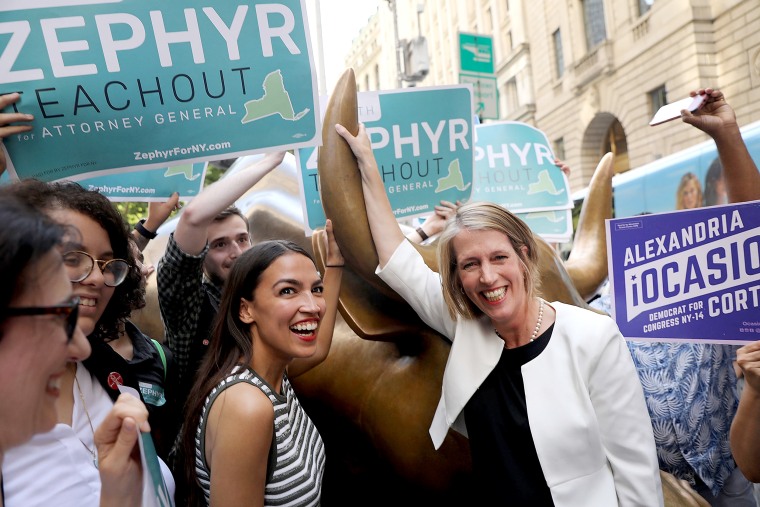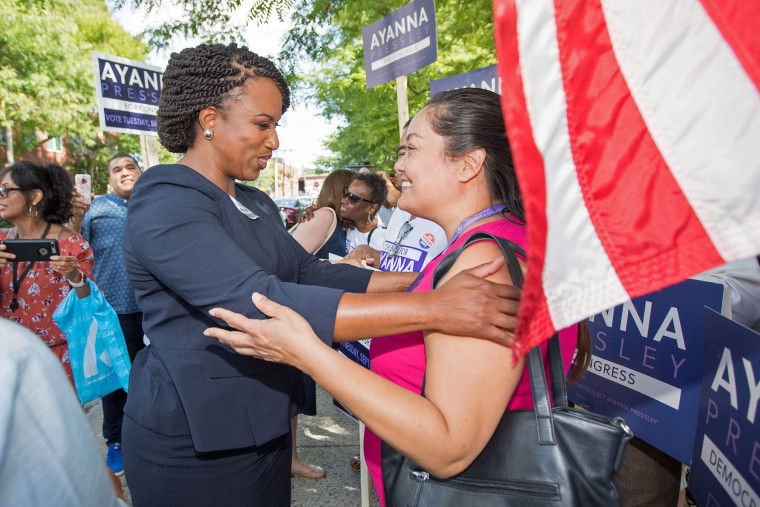WASHINGTON — In November, Americans could elect more than 100 women to the House for the first time in history — and put more new women in the House than in any prior election, a new race-by-race analysis shows.
But the impending surge is being driven entirely by Democrats: The number of Republican women in the House is actually poised to decline.
Between 30 and 40 new women are poised to enter the House next January, shattering the previous record of 24 set in 1992's "Year of the Woman." And much as pundits interpreted 1992's wave as a backlash against Clarence Thomas's Supreme Court confirmation, 2018 is now clearly a backlash to President Donald Trump's election.
Trump's victory over Hillary Clinton didn't just launch the Women's March; it set off an avalanche of Democratic women running for Congress, many of them first-time candidates, ranging from former Navy helicopter pilots to former CIA officers. Of the 254 non-incumbent Democratic nominees for the House, an unheard-of 50 percent are women, compared to 18 percent of Republicans.
Currently, there are 61 female Democrats and 23 female Republicans serving in the House. But after November, Democrats could expand their ranks of women by more than a third. Meanwhile, the GOP's ranks could shrink by up to a third.
Democratic primary voters have made clear they feel the best way to send a message to Trump is to send a woman to Congress: In Democratic House primaries featuring at least one man, one woman and no incumbent on the ballot, a female candidate has won 69 percent of the time. In the same situations on the GOP side, a female candidate has won just 35 percent of the time.
A pair of insurgent female progressives, Alexandria Ocasio-Cortez and Ayanna Pressley, defeated 20-year Democratic incumbents, Reps. Joe Crowley (NY-14) and Mike Capuano (MA-07), in highly symbolic primaries that made national headlines.
But Pennsylvania stands out as the state where Democratic women are poised to gain the most. In February, the state's top court ordered a new congressional map that prompted multiple GOP retirements and could help elect a quartet of Democratic women from the Philadelphia suburbs: Madeleine Dean (PA-04), Mary Gay Scanlon (PA-05), Chrissy Houlahan (PA-06) and Susan Wild (PA-07).
Texas could see the next-biggest surge: In March, Veronica Escobar (TX-16) and Sylvia Garcia (TX-29) won their primaries for safely Democratic open seats and are virtually guaranteed to become the first Latinas elected from the Lone Star State. Four other states have strong potential to add two Democratic women each: Florida, Michigan, Minnesota and Virginia.
Republicans, whose primaries have been defined much more by candidates' degree of loyalty to Trump, are headed in the opposite direction. Of the 23 GOP women in the House, four chose to run for another office this year and two are retiring. In Tennessee alone, Reps. Diane Black (TN-06) and Marsha Blackburn (TN-07) chose to run statewide and are all but certain to be succeeded by GOP men.
Of the remaining 17 GOP women in the House, three are at severe risk of losing re-election this fall: Reps. Mimi Walters (CA-45), Claudia Tenney (NY-22), Barbara Comstock (VA-10). An additional four are only slight favorites in their races. Meanwhile, there are only three states where House GOP women are poised to add to their ranks: New Mexico, South Carolina and West Virginia.

The House's burgeoning gender gap isn't the only demographic chasm on display in 2018; the parties are diverging along racial lines as well.
At the moment, 86 percent of House Republicans are white men, compared to 41 percent of House Democrats.
The race-by-race analysis suggests that could widen to 87 percent of Republicans and 37 percent of Democrats — a massive 50-point divide — come 2019. That would put Republicans increasingly at odds with the country, considering that white males now comprise just 31 percent of America's population.
David Wasserman, House editor for The Cook Political Report, is an NBC News contributor and senior analyst with the NBC Election Unit.
